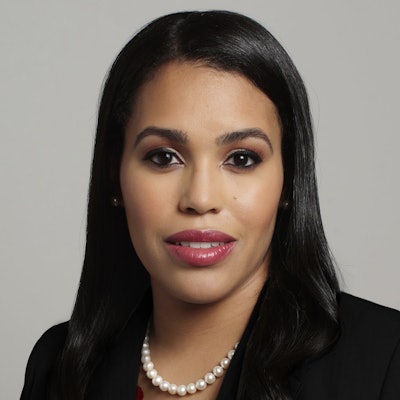Dr. Mautra Staley Jones has spent her whole career working with students who “check the boxes” of barriers that often disadvantage students in their pursuit of higher education. Dr. Mautra Staley Jones
Dr. Mautra Staley Jones
As a student at Oklahoma University, Jones majored in journalism, hoping to be an on-air broadcaster. However, she ended up working in the nonprofit and education sectors. She found she had a knack for organizational development and fundraising — skills that have proved critical at every stop of her career. She soon took a job as director of development and marketing at KIPP Reach College Preparatory Academy, a charter school in Oklahoma City that serves a population where 82% of the students are Black and 83% qualify for the federal free or reduced lunch program, an indicator of poverty.
“When I tell you being able to be fully immersed and make a difference” changed her whole career trajectory, says Jones, “I found my passion.”
In a lot of ways, Jones sees herself in her students — from the students at KIPP to the residents at White Fields, a live-in facility and school that takes a restorative approach to helping students who have faced trauma where Jones served as director of development from 2012 to 2015, to the students at Langston University, Oklahoma’s only historically Black institution where Jones most recently served as vice president for advancement and executive director of the university’s foundation. At Langston, 92% of students qualify for the federal Pell grant program and 70% are first-generation.
“I grew up similar to the students that I serve,” says Jones, who explains that she grew up in poverty, survived childhood abuse, faced food insecurity and was placed in the foster care system until her grandmother stepped in to help raise her and her siblings. “The things that I’ve gone through have really shaped me and placed this desire in me to help others on their journey through life.”
Jones says she’s thankful for the teachers, counselors, and others who knew her story and helped her to realize her potential.
“Education is the great equalizer. It just is. Education has opened up so many doors. It’s been the gateway for me, because had I not been brave — there were so many things that I didn’t see carried out at home,” she says. “As a child, you don’t understand your circumstances, you don’t understand why things are the way they are.”
All of her experiences have prepared her for the next chapter. On March 1, Jones became the first Black or other person of color and the first woman president of Oklahoma City Community College (OCCC). She is also the first Black woman to lead any higher ed institution in the state of Oklahoma that is not an HBCU.
“That’s really significant to me. … When I think about the ceiling being broken, the significance of it is that I think and I hope that my journey inspires every single person out there — no matter their journey, path, position in life, race — to say, ‘I can do anything I set my mind to,’” Jones says.
At OCCC, 55% of the students are people of color, and a lot of their challenges mirror those she’s been navigating her entire life, both personally and professionally. She was, in every sense, built for this role.
“It’s simple: I understand all too well the realities that students whose backgrounds and experiences mirror mine, I understand the realities they face, because I was that person,” she says. But not only that, when she first read the job description she immediately thought, “this is me!”
Jones is looking forward to building “a culture of philanthropy” at the college, which is celebrating its 50th anniversary this year. But more than anything, she’s looking forward to taking “that unrelenting drive to ensure that our students have the resources they need to be successful.”
She says her first job is to listen and understand what the various constituencies want and need — “I want to create a positive people culture where every employee knows that they’re valued and they have a voice and we’re going to go on this journey together,” Jones says. “Unification is a big part of how I lead.”
That approach may be necessary as Jones tries to balance the politically divisive climate and efforts in Oklahoma to ban critical race theory and any discussions of diversity with the fact that the majority of her students come from marginalized backgrounds.
"I’m excited about this next journey — to me, it’s just been one building block on top of another,” Jones says. “At every stage, I’ve been able to increase those that I’ve served,” she adds. “I started out in my KIPP days with 300 students and now it’s over 17,000.”
This article originally appeared in the March 31, 2022 edition of Diverse.















